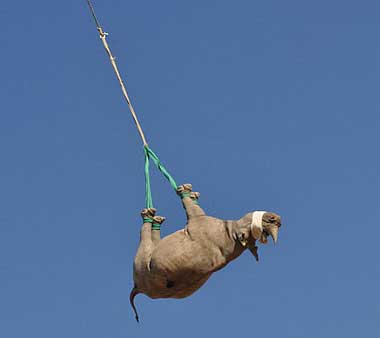4 Feb 2021
“Hanging rhinos upside down actually improved ventilation (albeit to a small degree) over rhinos lying on their sides” – Robin Radcliffe, Cornell University.

Image © Cornell University
A study led by the Cornell University College of Veterinary Medicine has looked at the effects of hanging tranquillised black rhinoceroses upside down by their feet.
To keep rhinos safe from poaching and to distribute individuals across habitats so their gene pools stay healthy, management teams often have to move rhinos in remote areas that cannot be accessed by roads or automobiles.

This often leaves one option: tranquillising and airlifting the giant mammals out with a helicopter.
Transporting the rare creatures is often done using a platform or a sledge with the rhinos lying on their side, but is occasionally done by suspending the animal by its feet.
Researchers predicted this method could exacerbate the dangerous effects of the powerful opioids used to tranquillise the animals – it is known horses in this position suffer from impaired breathing, likely due to the heavy abdominal organs pushing against the lungs and chest cavity.
However, the study – published in the Journal of Wildlife Diseases – showed the technique to be no worse for rhinos’ pulmonary function than lying on their sides.
Robin Radcliffe is senior lecturer in wildlife and conservation medicine at Cornell and first author of the study.
He said: “Hanging rhinos upside down actually improved ventilation (albeit to a small degree) over rhinos lying on their sides.
“While this was unexpected, and the margins small, any incremental improvement in physiology helps to enhance safety of black rhinoceroses during capture and anaesthesia.”